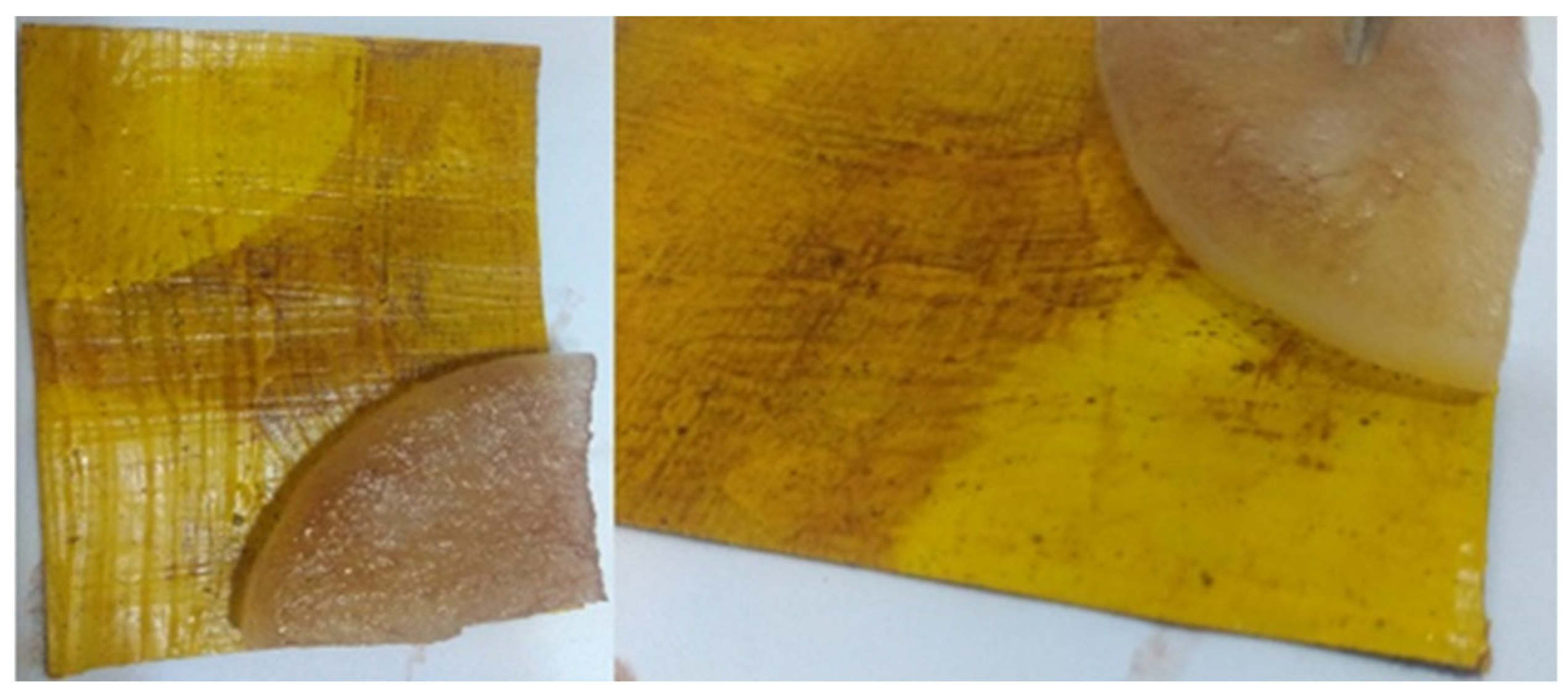Evaluation of PVA-Based Cryogels in the Cleaning Process of Contemporary Acrylic Paintings †
Author Contributions
Funding
Institutional Review Board Statement
Informed Consent Statement
Data Availability Statement
Conflicts of Interest
References
- Linhares, J.; Cardeira, L.Q.; Bailão, A.; Pastilha, R.; Nascimento, S. Chromatic changes in paintings of Adriano de Sousa Lopes after the removal of aged varnish. Conserv. Patrim. 2020, 34, 50–64. [Google Scholar] [CrossRef]
- Mecklenburg, M.; Koestler, R.J.; Charola, A.E. New Insights into the Cleaning of Paintings, Proceedings from the Cleaning 2010 International Conference, Universidad Politécnica de Valencia and Museum Conservation Institute; Smithsonian Institution Scholarly Press: Washington, DC, USA, 2013; pp. 1–243. [Google Scholar] [CrossRef]
- Bronwyn, A.; Soldano, O.A.; Keefe, M.H.; Phenix, A.; Learner, T. An Empirical Evaluation of a Range of Cleaning Agents for Removing Dirt from Artists’ Acrylic Emulsion Paints. AIC Paintings Specialty Group Postprints 23. Presented at the 38th Annual Meeting of the American Institute for Conservation and Historic Works, Milwaukee, WI, USA, 11–14 May 2010; pp. 77–87. [Google Scholar]
- Chelazzi, D.; Bordes, R.; Giorgi, R.; Holmberg, K.; Baglioni, P. The use of surfactants in the cleaning of works of art. Curr. Opin. Colloid Interface Sci. 2020, 45, 108–123. [Google Scholar] [CrossRef]

Publisher’s Note: MDPI stays neutral with regard to jurisdictional claims in published maps and institutional affiliations. |
© 2022 by the authors. Licensee MDPI, Basel, Switzerland. This article is an open access article distributed under the terms and conditions of the Creative Commons Attribution (CC BY) license (https://creativecommons.org/licenses/by/4.0/).
Share and Cite
Vasile, D.A.; Rizescu, C.E.; Zaulet, I.O.; Vincze, I.; Marin, L.; Ion, R.-M. Evaluation of PVA-Based Cryogels in the Cleaning Process of Contemporary Acrylic Paintings. Chem. Proc. 2022, 7, 44. https://doi.org/10.3390/chemproc2022007044
Vasile DA, Rizescu CE, Zaulet IO, Vincze I, Marin L, Ion R-M. Evaluation of PVA-Based Cryogels in the Cleaning Process of Contemporary Acrylic Paintings. Chemistry Proceedings. 2022; 7(1):44. https://doi.org/10.3390/chemproc2022007044
Chicago/Turabian StyleVasile, Dan Adrian, Claudiu Eduard Rizescu, Ionut Octavian Zaulet, Irisz Vincze, Laurentiu Marin, and Rodica-Mariana Ion. 2022. "Evaluation of PVA-Based Cryogels in the Cleaning Process of Contemporary Acrylic Paintings" Chemistry Proceedings 7, no. 1: 44. https://doi.org/10.3390/chemproc2022007044
APA StyleVasile, D. A., Rizescu, C. E., Zaulet, I. O., Vincze, I., Marin, L., & Ion, R.-M. (2022). Evaluation of PVA-Based Cryogels in the Cleaning Process of Contemporary Acrylic Paintings. Chemistry Proceedings, 7(1), 44. https://doi.org/10.3390/chemproc2022007044





